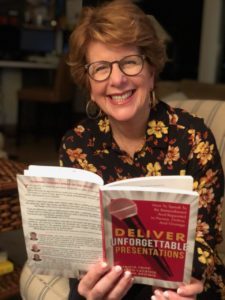Let’s look at some not-so-basic story basics.
Stories and examples are best when they come from your experience. Your audience has a chance to relive them from their perspective. Here is an important point to make your stories credible.
Point one, make your story part of your own experience. If you tell a story that belongs to the world—in other words, it is well known from a best-selling book, or they’ve been teaching it for years in the Dale Carnegie course—you lose your credibility. If your stories are in the public domain, your audience is familiar with it and knows it does not come from your experience. Your entire presentation then is flavored that it’s not original, fresh, or leading edge.
I’ll never forget getting off a plane and meeting a client who said, “Patricia, I just heard Barbara Bush speak. She told your Bobby Lewis story.”
At the time, I imagined Barbara Bush sitting in bed in Houston with the book, Chicken Soup for the Soul, putting together a speech. That is where my story was published, and I assume the way it worked into her speech. After speaking at the Ragan speech writing conference, I realized the speech writer was preparing her speech for her. As good as my Bobby Lewis story is, Barbara Bush and her speech writer shortchanged her audience. She has lived a fascinating life. Don’t you think the audience wanted to hear her own stories, not mine?
Based on their overwhelming success, I do not recommend you tell stories from the Chicken Soup of the Soul series, unless you wrote the story. Does that mean you can’t repeat a story you heard? Well, give credit to where the story came from. Never pretend it happened to you. You can mention and even retell a good story you heard from a speaker, your boss, or an industry expert, if you don’t claim it was from your life experience. Then you tie into your experience that builds on the point that you are making; you owe it to your audience to use stories from your life.
Time for a couple of questions. Are you ready? When do you tell stories that are in the public domain? FrippVT is interactive
What Is Behind the Creative Presentation Process: Where Do You Begin?
There are three ingredients that go into every presentation you will deliver.
There is the content—what it is you are going to put in your conversation or presentation. There is the structure of how you organize your remarks, and then you add the opening and closing scripting. Next, you work on the delivery.
Perhaps you think, “Oh, I want to be a more dynamic speaker. Let’s look at how I deliver my message.” Important as your delivery is, if you have a strong, logical conversational structure with good scripting, your delivery will be easier for you to be professional.
The difference between a conversation and a conversationally sounding speech or presentation is we think in advance about what is the best way to deliver our message. Do not use words in a presentation that you would not use in conversation. However, we want our remarks to be tighter and more specific.
In 2023, will your presentations be unforgettable?

Why not take a trial of FrippVT Powerful, Persuasive Presentations?
“Patricia, you saved the day! I was summoned on rather short notice to speak as a keynote speaker for our corporate annual sales conference. My task was to relate technical details to a non-technical audience.
Lucky for me, a week in advance I found FrippVT. I worked tirelessly devouring the FrippVT content most evenings until 2 a.m. to perform at the highest level possible.
Can you imagine my excitement to walk off stage and hear, ‘You stole the show,’ ‘Are you a professional speaker?’ and ‘The audience was hanging onto your every word.’ I cannot thank you enough for creating FrippVT. Having your wisdom, advice, and guidance 24/7 throughout my preparation for this speaking engagement. Consider me your biggest fan.”
Scott Lelii, Head of Digital & IT, Volvo Construction Equipment Sales Regions North & Latin America, Sean Youngberg

